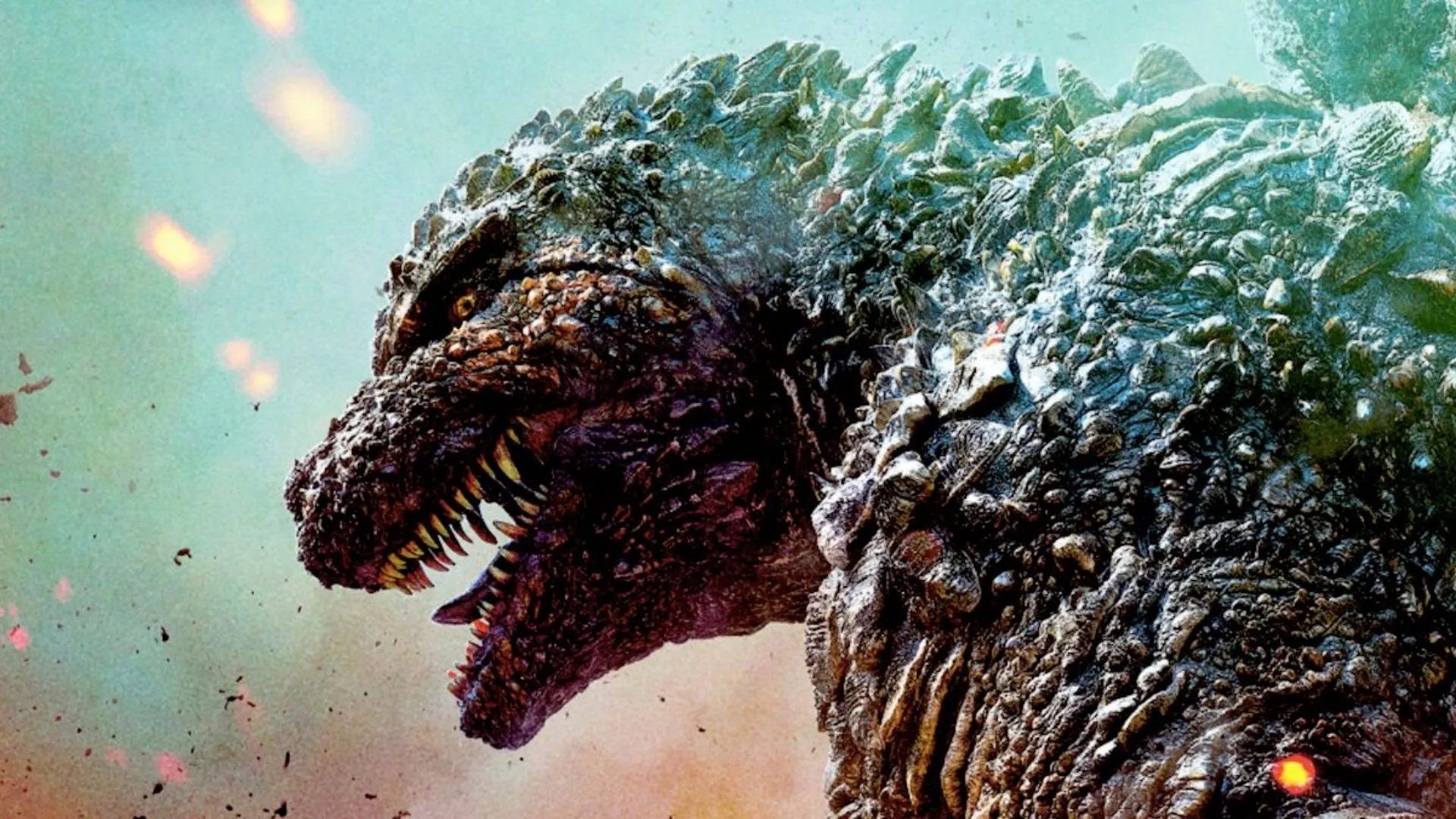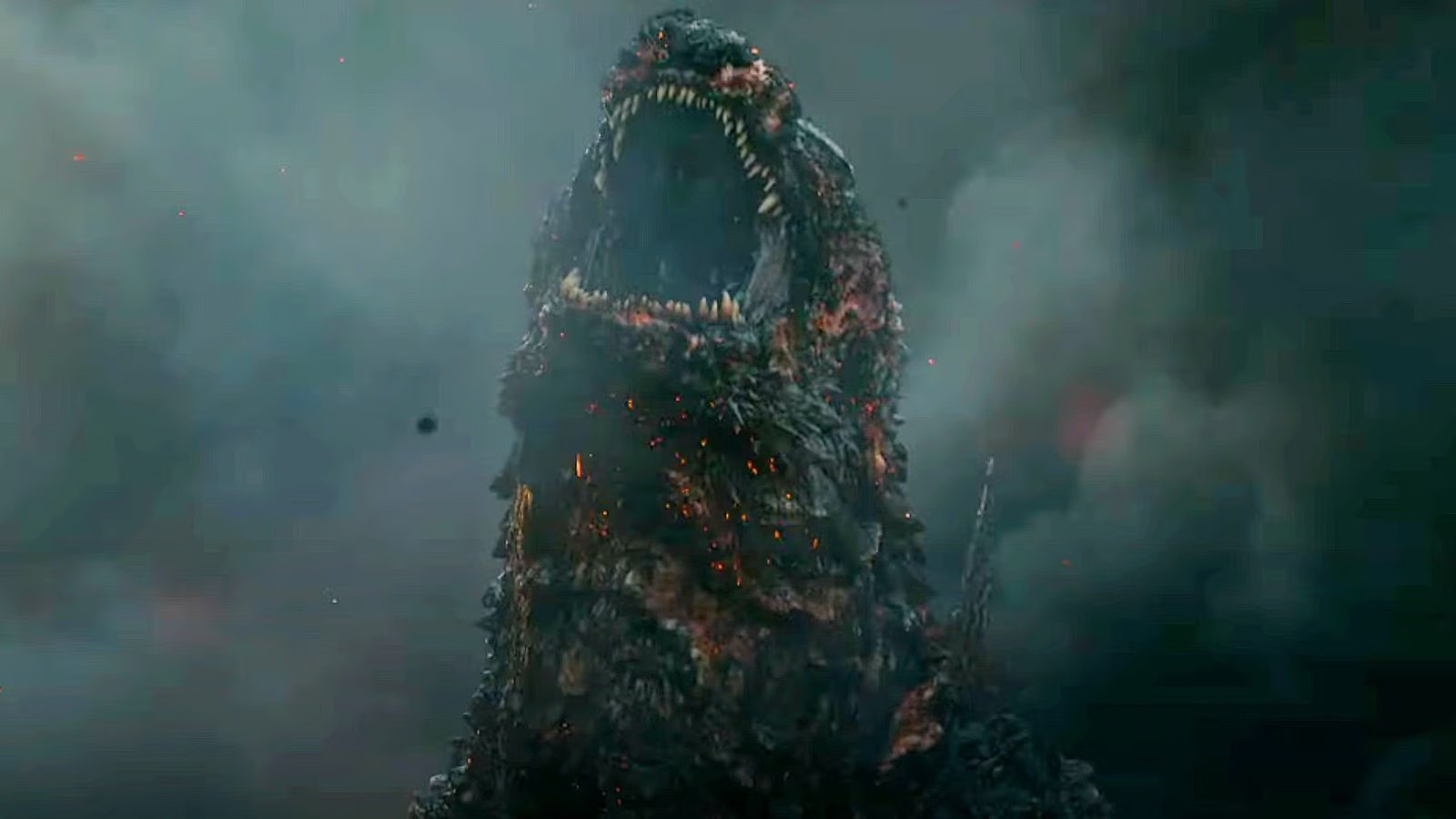There are essentially two types of Godzilla films. The first depicts the iconic King of the Monsters as a nigh unstoppable force of nature leaving a swath of destruction in its wake. The entries featuring this approach are generally darker and are relatively thematically complex. The second posits the giant irradiated reptile as more of an antihero and leans into more comic book-y action elements. I’m speaking of the Japanese films, as the American productions are a different beast, so to speak. Writer/director/digital effects wizard Takashi Yamazaki’s Godzilla Minus One falls under the former designation.
Our lead is Koichi (Ryunosuke Kamiki), a Japanese kamikaze pilot in the waning days of World War II. Unwilling to fulfill his deadly assignment, he pretends that his plane is malfunctioning and lands on a small island outpost. It is here where he first crosses paths with Godzilla. The kaiju massacres the small force of military mechanics, but Koichi survives, leaving the soldier wracked with guilt.
When he arrives back home to a Tokyo devastated by American bombings, he meets Noriko (Minami Hamabe). The young woman’s family was killed in the bombings, as were Koichi’s parents. Along with the orphaned infant Akiko (Saki Nakatani), they form a makeshift family out of the rubble of their lives. However, Koichi’s trauma creates a wall between him and those he loves.
In the years that follow, Japan begins to rebuild and Koichi’s new family starts to flourish. Soon, though, a Godzilla mutated and enlarged by atomic testing makes its presence known by sinking an American warship. Koichi, now a mineman clearing leftover mines from Japanese waters, encounters the monster again in the aftermath of this attack. It won’t be the last time. Significant supporting roles also belong to Sakura Ando as the family’s blunt neighbor, Hidetaka Yoshioka as an upbeat scientist, and Munetaka Aoki as an aggrieved mechanic.
While Godzilla Minus One is not as overtly satirical as Shin Godzilla (the previous Reiwa era franchise entry from 2016), Yamazaki’s script still showcases some thematic complexity. Many of the more serious franchise entries examine Japan’s struggles with its militaristic imperial past. Here that theme is brought down to the personal level and embodied by Koichi’s ongoing anguish and his arc in general. Yamazaki also subverts what we might expect out of a franchise giant monster flick by pursuing a character-centric drama aesthetic. Koichi and company feel like some of the most grounded and fully realized characters in the decades-long history of the franchise. In some ways, the movie feels closer in tone to something like Christopher Nolan’s Dunkirk more than, say, Adam Wingard’s Godzilla vs. Kong. In any case, Yamazaki sets his targets on a certain dramatic realism and mostly succeeds.
That’s not to say there isn’t any action. Set pieces are actually thrillingly executed. Godzilla’s invasion of Tokyo nods toward series originator Gojira from 1954 while carving its own destructive path. The moment that punctuates this sequence is my favorite shot in the film, with Godzilla triumphantly basking in the shadow of a mushroom cloud. Kudos to cinematographer Kozo Shibasaki for creating several indelible images throughout the film, such as Godzilla menacingly swimming just beneath a warship and the camera tracking along Godzilla’s spinal plates as they pop out in preparation for the unleashing of its atomic breath. Considering Godzilla Minus One’s budget was about 1/20th of its American counterparts, it’s astounding how good the effects look.
Shibasaki nails the quieter moments, as well. Scenes like the one where Koichi reveals to Noriko what his new dangerous job entails or where Koichi’s coworkers come over for dinner are integral to the mood and the overall story. Sets, costumes, and locations all look amazing and immerse you in the world of postwar Japan. Ryuji Miyajima’s editing weaves all this together and assists in making the 125-minute runtime blow by. Now, that all being said, if I have one nitpick about the film, it’s that it could use just a little more monster-stomping action. That’s truly a minor complaint, though.
The performances are all excellent. Kamiki is wonderful as the haunted Koichi. He garners our sympathies and we experience all his horror, fear, longing, and determination organically. It’s a pleasingly naturalistic turn. I do wish that the script would’ve devoted as much attention to Hamabe’s Noriko, as her introduction showed a bit of a mischievous streak that doesn’t really get any follow-up. She does get to show some strength in the face of Koichi’s despair, though. Godzilla himself is beautifully realized via CGI and the character design seems to be a marriage of his traditional Japanese looks and the beefier Monsterverse version.
Naoki Sato’s instrumental score is subtle at times but swells at all the right moments. I especially appreciated the more somber notes it hit during character beats. Thankfully, though, Yamazaki realizes that no Godzilla movie is complete without Akira Ifukube’s towering theme music, and it’s deployed in a couple of instances for maximum effect. When combined with the immense IMAX visuals, the theme thunders its way into your imagination and truly brings Godzilla to life.
Takashi Yamazaki’s Godzilla Minus One takes the series back to its roots but gives it a different spin. The specter of nuclear destruction is still present underneath the surface of the story, but monstrous guilt and regret dominate the subtext. It’s an accessible film, in that it doesn’t have a connection to any previous Godzilla flick and requires no foreknowledge of the franchise. It might be slightly too intense for younger kids, but it’s enjoyable on a surface level as a well-made giant monster movie. Subtitles linger long enough that I’d think most folks won’t have a problem keeping up with the dialog. As a huge Godzilla fan, I was thoroughly satisfied with the film (though I hope Toho isn’t completely done with man-in-suit productions). Highly recommended for fans of the aforementioned Dunkirk, the Barefoot Gen manga by Keiji Nakazawa, and James Stokoe’s Godzilla: The Half-Century War graphic novel.
Michael Cavender




